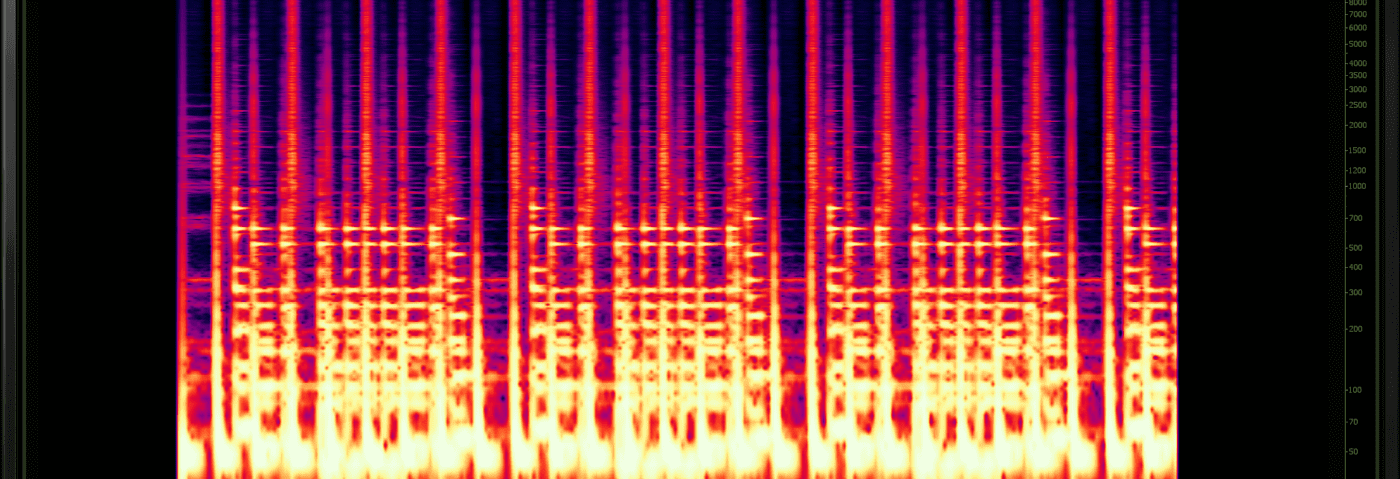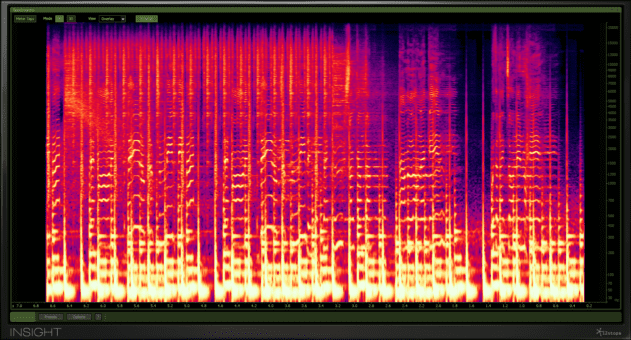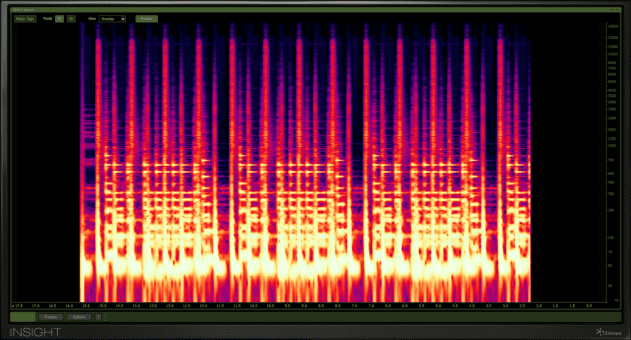‘Look Right Through’
A similar use of spectrogram analysis helps us to compare two section of the MK remix of Storm Queen’s ‘Look Right Through:
On the left half there’s plenty of high frequency energy coming from the hi-hats and other percussion. Moving to the right, the track breaks down to kick and bass elements, interrupted every so often by the vocal.
If we turn to the ‘MK Dub III’ version of the track, near the end there’s a section without vocal:
For the image above we’ve used a frequency scale that reveals a bit more detail in the bass end. The claps are easily visible (the regular vertical bands running up to 15 kHz). Moving at double their pace you can also see the kicks. The changing horizontal bands from 200-700 Hz are the organ chords. Below 70 Hz you can see what appear to be the root notes of the organ chord. Audibly, this sounds like it’s heavily supported by a simple sub-bass note.
The approach MK employs throughout his ‘Look Right Through’ remix is a very modern one, giving each mix element acres of space in which to do its thing. Perhaps most importantly, it allows the kick, bass and sub-bass to be the main focus of the entire track, with a sparse arrangement above them so as not to crowd the mix.
In some respects, ‘Look Right Through’ is a similar mix to ‘Good Life’ – both are quite poppy vocal tracks with a clean, clear approach to the mix – but the difference illustrates the way approaches to mixing have evolved in the quarter of a century between the two tracks being made. The more sparse arrangement and low-frequency focus of MK’s mix mean that the dancefloor impact of ‘Look Right Through’ is (in sonic terms at least) far greater.



08.49 AM
Damn, what an article. Great stuff Attack.
And now I really want to hear New for U mixed like a Skirllex track. I’ll whack it through Pro L later with +30 on the gain.
01.11 PM
I would just like to say that Big Fun has greater floor impact than Look Right Through :p (played at same subjective volume of course..)
02.45 PM
Excellent Article … useful.
09.34 PM
I just want a spectrogram.
04.03 PM
i think “scary monsters and nice sprites” would sound way better as a more dynamic mix, personally. *Shrugs
03.21 PM
useful indepth article, well done to the author.
12.15 PM
Two points –
1) One thing that bugs me about the mix of the more synthetic side of dance music is how hot the highs are. Spend an afternoon with 70s vinyl: pop, rock, jazz…
I know this is media-influenced but all the mixes roll the high ends off a lot – then you come to any more modern (90s+) techno or whatnot, and the closed hats are relatively screaming at you in the mix. Sometimes I wonder if this is because everyone’s lost their hearing.
2) As a DJ primarily I’ve noticed that over the past 5 years or so, more and more dancefloor music is mastered just to be loud. This plays havoc when metering and mixing older and newer tunes, especially if you like to mix cross-genre – imagine mixing that skrillex track into Andres (just ignore the cognitive dissonance about that one). The house track’s fader will be at say 80-90% max and the other track will be at 20%. Visual metering as an aid fails. You can make it work by ear, but even then if you’re mixing kind of loud, when you relisten in a better environment, the disparity is huge.
—
I’m very pro-mp3/digital audio, but at least when you’re vinyl only, the mastering variation among songs, wrt loudness is pretty constrained.
08.26 PM
Great article!
I remember New For U was released digitally on Derrick Mays cd of the We Love Detroit compilation. If I got a copy I’d like to compare the vinyl rip with the (probably processed) digital version like the author did with Good Life
01.21 PM
Want to mix better and be able to pinpoint problem frequencies by heart? Then Train Your Ears! https://www.trainyourears.com/mixlikeapro